Lizards in Maryland” account for seven fascinating species, six of which are native to the state. As one of the most common types of reptiles visible in Maryland, lizards can be found in various settings, from backyards to deep wilderness, each one being distinctive and often secretive.
This exploration into Maryland’s lizard populace goes beyond a simple species list – it uncovers interesting characteristics of each type, their unique behaviors, coloration, and habitats, allowing for accurate identification.
Table of Contents
Lizards in Maryland
Scincidae
1. Broad-headed Skink

- Experience Level: Intermediate
- Family: Scincidae
- Scientific Name: Plestiodon laticeps
- Other Names: Red-headed Scorpion
- Adult Size: 5.9 to 13 in. (15 to 33 cm.)
- Lifespan: 4 to 8 years
- Average Price Range: n/a
The broad-headed skink is native to the southeastern and central United States. These skinks are most commonly observed in the coastal plains of the Eastern Shore and Southern Maryland. Broad-headed skinks are a forest species and can be found in both moist and dry wooded areas of Maryland. They are extremely arboreal and spend most of their time high in the treetops but are also sometimes seen around low sandy hills and knolls during the day.
Maryland’s largest species of skink is the Broad-headed skink which can grow to over a foot long. This species can be mistaken for the five-lined skink due to their similar appearance. The adult males of this species are normally a solid brown or olive color with red/orange jaws that become swollen during mating season. Females tend to be dark brown or grayish in color.
While broad-headed skinks spend a large amount of their time high in the treetops they do spend some time foraging for food on the ground among the woodland debris. They eat a wide variety of insects and arthropods including most species of bees and wasps. While they prefer a diet of insects they will occasionally eat small rodents and reptiles.
2. Common Five-lined Skink
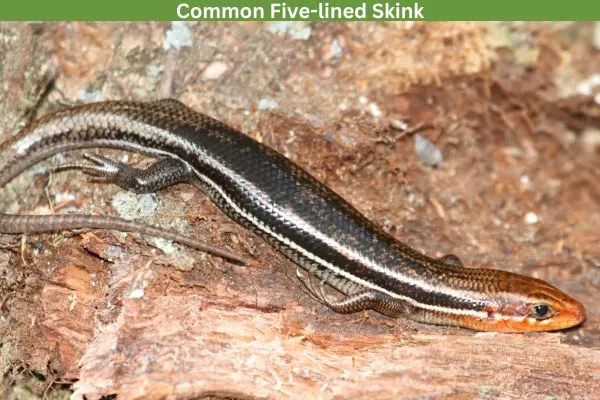
- Experience Level: Intermediate
- Family: Scincidae
- Scientific Name: Plestiodon fasciatus
- Other Names: American
- Adult Size: 4.9 to 8.5 in. (12.5 to 21.5 cm)
- Lifespan: 6 years
- Average Price Range: $12
The common five-lined skink is found all throughout Maryland but most commonly seen along the Coastal Plain. They are generally found in forests and other moist wooded areas with lots of leaf litter and rotting logs. This species of skink is mostly terrestrial and can be found hiding under rocks, and other coarse debris. These lizards are usually the ones found in backyards and on porches of Maryland’s residents.
Hatchlings and juvenile five-lined skinks are black with 5 white or light yellow stripes down their back. As these skinks grow into adults these lines fade and males turn a uniform olive or tan color while females fade into a dark brown or gray color. During the mating season adult males have red-orange coloring on their jaws.
The five-lined skink has a diet consisting of spiders and a variety of insects like crickets, beetles, moths, and bees. These lizards can easily be spotted basking during sunny days. While it is tempting to want to catch one the five-lined skink is quick to bite when handled. Their bites can hurt but rarely break skin.
3. Coal Skink
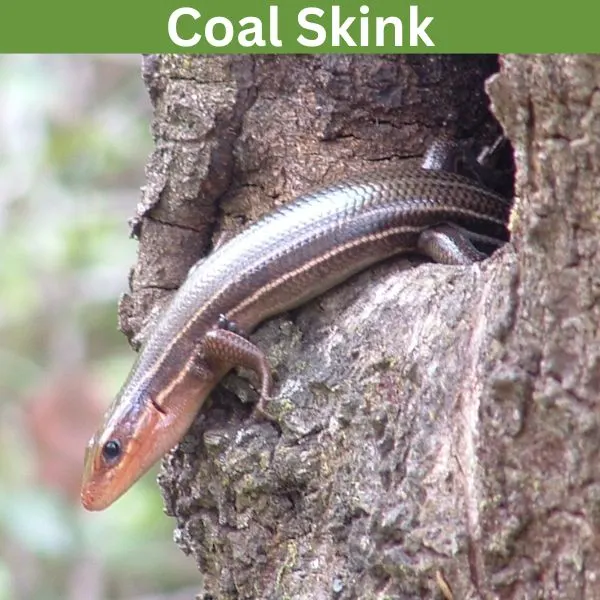
- Experience Level: Intermediate
- Family: Scincidae
- Scientific Name: Plestiodon anthracinus
- Other Names: n/a
- Adult Size: 5.1 to 7.1 in. (13 to 18 cm.)
- Lifespan: 6 years
- Average Price Range: n/a
Coal skinks are found in Maryland though they are uncommon. They have only been found in the northwest corner of the state. These skinks are very secretive and are unlikely to be found out in the open. They live in moist wooded areas and are typically found underneath rotting leaf litter, rocks, and other woodland debris.
The coal skink has four light colored stripes and two wide dark brown or black stripes on its sides. The hatchlings are jet-black with blue coloring on the end of the tail. They juveniles often lack the stripes adults have. As these lizards age they lose the blue coloring on their tails. The jet-black body color fades to dark or reddish brown and reveals the stripes on either side of the body as they reach adulthood.
Like the other skinks of Maryland the diet of the coal skink is made up of a variety of arthropods and insects. However, coal skinks that live near streams may also eat crustaceans. Due to their secrecy they mostly hunt for their food under the woodland debris around their home. If they do leave their home to find food they stay very close.
4. Little Brown Skink
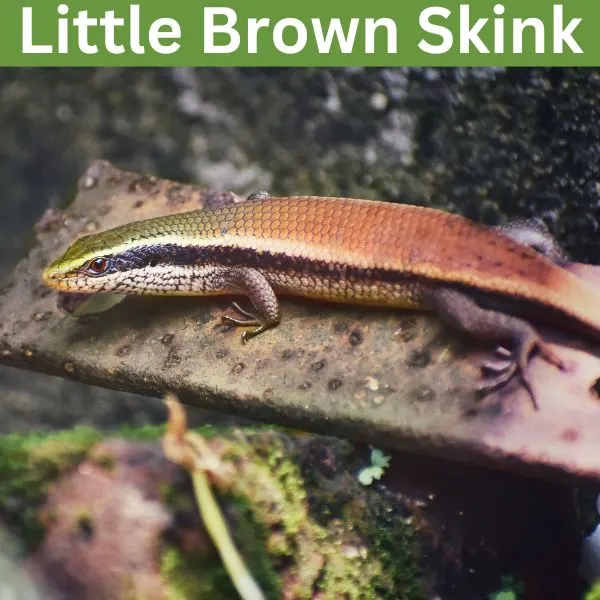
- Experience Level: Beginner
- Family: Scincidae
- Scientific Name: Scincella lateralis
- Other Names: Ground Skink, Brown-backed Skink
- Adult Size: 3 to 5.25 in. (7.62 to 13.3 cm.)
- Lifespan: 2.5 years
- Average Price Range: $5
Little brown skinks are found in a majority of Maryland but are most commonly found in the Coastal Plain of southern Maryland and the Eastern Shore. They prefer to live in moist forests with loose soil. Little brown skinks can also be found in gardens or urban areas with loose soil and lots of leaf litter and ground debris. These lizards are also referred to as ground skinks because they like to live on the forest floor.
Like the name suggests little brown skinks are in fact brown. They are typically copper brown but can also be found having golden brown or dark brown skin. They have light yellow or white underbellies and two black or dark brown stripes on either side of the body. These skinks are the only skinks in Maryland to look the same from birth to adulthood.
The little brown skink are able to climb but rarely do because they spend most of their time on the ground foraging for food or evading predators. Their diet is made up of various arthropods and small invertebrates. The skinks are unique in their ability to see with their eyes closed. They have a little window in their lower eyelids so they can always see.
Teiidae
5. Six-lined Racerunner
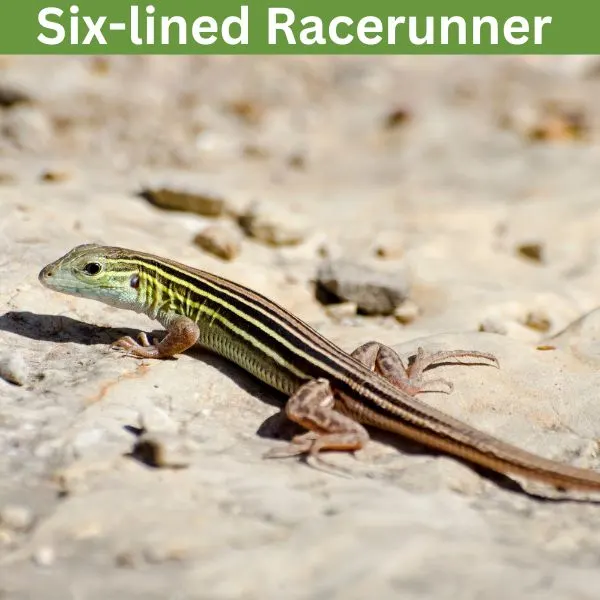
- Experience Level: Intermediate
- Family: Teiidae
- Scientific Name: Aspidoscelis sexlineatus
- Other Names: Sandlapper lizard
- Adult Size: 6 to 9.5 in. (15 to 24 cm.)
- Lifespan: 4 to 5 years
- Average Price Range: $30
The six-lined racerunner is found in Maryland, and other regions within the eastern United States. This species lives in various habitats like grasslands, swamps, and rocky regions. They prefer lower elevations, with a dry climate. They are often found in places like on the side of roads, and railways.
Six-lined racerunners are named after the six yellowish, or orange lines that appear down their back. This species has an olive to black coloring, with a slender body, long tail, and long toes. Six-lined racerunners’ very long tail helps them escape predators.
Six-lined racerunners are active from the spring to summer months. This lizard feeds on insects like beetles, and crickets, while fire ants, and snakes prey on them. Six-lined racerunners are common, but very quick, and escape to hiding places if spotted.
Phrynosomatidae
6. Eastern Fence Lizard
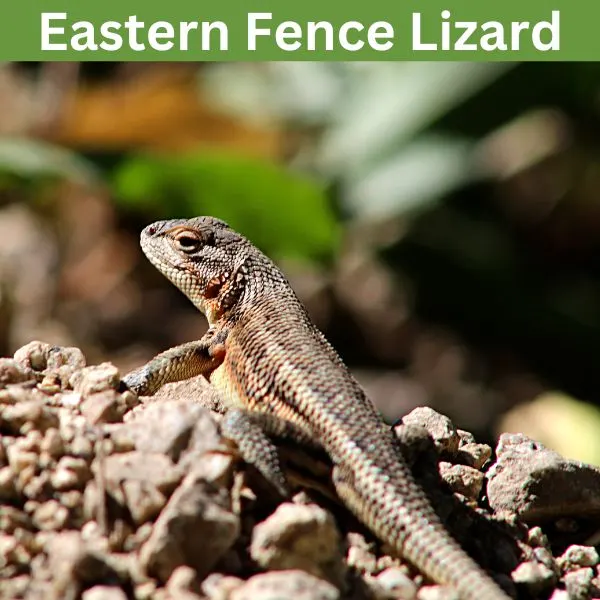
- Experience Level: Intermediate
- Family: Phrynosomatidae
- Scientific Name: Sceloporus undulatus
- Other Names: Prairie lizard, fence swift, pine lizard, gray lizard
- Adult Size: 4 to 7.25 in. (10.16 to 18.41 cm.)
- Lifespan: 4 years
- Average Price Range: $20
Eastern fence lizards are a species found in the Eastern United States, and are a native lizard to Maryland. This lizard lives in woodland, and urban habitats. They are active during the day, often seen basking in the sun on fences.
Eastern fence lizards have a gray to tan color, with very keeled scales. Males may have blue coloring in their underside. The color of this lizard helps them camouflage into wooden surfaces like fences or trees. This lizard is medium sized, with sharp claws to help them climb.
Insects, spiders, and other invertebrates are what this lizard eats. They are active from spring to fall, and in the winter hibernate. This lizard may be preyed on by animals like foxes, cats, and birds.
Gekkonidae
7. Mediterranean House Gecko

- Experience Level: Beginner
- Family: Gekkonidae
- Scientific Name: Hemidactylus turcicus
- Other Names: Turkish gecko
- Adult Size: 3 to 6 in. (7.62 to 15.24 cm.)
- Lifespan: 9 years
- Average Price Range: $10
The Mediterranean house gecko is an invasive lizard that lives in Maryland. This species is originally native to the Mediterranean region, but has been introduced to North America through trade. Mediterranean house geckos are primarily found in urban, and suburban habitats. They are active at night, often seen climbing on walls, and other structures.
This gecko is medium sized, with tan, to cream coloring. They have very bumpy skin, with brown spots on them. The eyes of this lizard are yellow, with elliptical shaped pupils. They have toe pads on their feet to help them climb, with a thick tail. Mediterranean house geckos have stripes on their tail, and like other lizards can drop their tail if attacked.
Mediterranean house geckos are active in the night, and hunt for insects like moths, beetles, and spiders. This gecko is active near light sources, and other areas with lots of insect traffic. These lizards in the day hide in a crevice. When active they sometimes make chirping noises to communicate with one another.
FAQ
What invasive lizards live in Maryland?
The Mediterranean house gecko is the only invasive lizard that can be found in Maryland. This species is very rare, and is believed to have been introduced in the United States through cargo shipments from other countries.
In Maryland what is the largest lizard species?
The broad-headed skink is the largest lizard species that lives in Maryland, and is also one of the largest skinks found in the United States. When measured with their tail broad-headed skinks are able to grow up to 13 in. (33 cm.) in length, and they get their name from their very broad heads.
What is the most common lizard in Maryland?
Common five lined skink are one of the most common lizards in Maryland. These lizards can be found all across the state, and are seen from forests, to urban areas. Common five-lined skinks are a very common species in their overall range, and have a stable population.
Wrapping up
There are around 7 lizard species that you may find in Maryland. Lizards are important animals since they not only help control the population of animals like insects, but are also used for food by various types of carnivores. Lizards are very secretive, and if spotted, typically flee.
It can be easy to not see the lizards near you, but when you know where and when to search you may find lizards in places you never thought to look. Lizards can make great pets, and learning about them will help you know what species are best to keep.
The ecosystem of Maryland is very diverse, filled with habitats like grasslands, swamps, and forests. Protecting the wilderness of Maryland will also help persevere the animals like lizards that live within it.
More lizards in other nearby states
